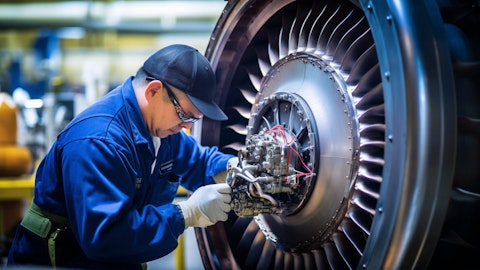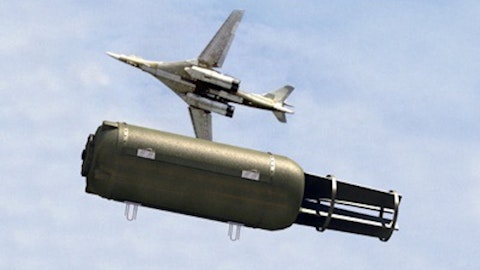Bert Subin: Great. Thanks so much.
John Holmes: Thank you.
Operator: Thank you. One moment for our next question. And that will come from the line of Josh Sullivan with The Benchmark Company. Your line is open.
Josh Sullivan: Hey. Good afternoon.
John Holmes: Hey, Josh.
Josh Sullivan: John, you called out the GTF issues just in your prepared remarks. What’s your sense on how long the cycle looks like on the supplemental GTF worker? What is the peak in your view at this point?
John Holmes: I think that is a very popular question to ask in the industry right now. So I don’t know that I can give you better insight than anyone else. What I would say though is that, generally speaking, between that and the slower overall aircraft introduction, we expect the elevated demand to be measured in years.
Josh Sullivan: Got it. Got it. And then on the CFM-CP [ph] relationship, should we expect additional similar relationships to follow down the pipe? Is the relationship with FTAI maturing to a point where you’re expecting an increase in volume of parts at this point?
John Holmes: Yeah. The relationship with FTAI is going very, very well. They’re great partners. The relationship has grown beyond the initial expectations and both of us have expectations that it will continue to grow from here. So that is a meaningful contributor to the USM business and we expect that to continue to grow.
Josh Sullivan: And then just as far as expansion to Asian markets, particularly with the Triumph that’s, where do you think that the biggest opportunity is? Is it organic, do you think it’s taking share from internal airline capabilities or third-party suppliers?
John Holmes: Yeah. Great question. We — one of the most attractive things about the Triumph acquisition was the facility they have in Asia. They’ve got very unique capability over there, particularly on the structure side. They are set up with next-gen capabilities to move into platforms like the 787, the A350 and as — and that’s where the majority of those fleets in the world are going. So as those fleets mature, we are only — what we are — we’ll be one of the four providers of structure repair capability in the region to support those large fleets and that’s organic growth as the new aircraft mature. Furthermore, we see opportunities to expand the capability on the component and accessory side as well in that facility.
We’re looking at investment opportunities that we can make there to broaden the capability in the region, because the competitive set there is somewhat limited if a lot of that work comes back to the West. So we see a lot of opportunity now having a very solid footprint in Asia.
Josh Sullivan: Got it. Thank you for your time.
John Holmes: Great. Thank you.
Operator: Thank you. One moment for our next question. And that will come from the line of Sam Struhsaker with Truist Securities. Your line is open.
Sam Struhsaker: Hey, guys. On for Mike Ciarmoli this evening.
John Holmes: Hey, Sam.
Sam Struhsaker: How are you guys doing? I was very curious…
John Holmes: Great.
Sam Struhsaker: … if you guys maybe talk in a little more detail about kind of the trajectory of the integration costs for the acquisition moving forward. And then in addition to that, maybe cover a little bit more how you’re thinking about the pre-tax flow profile in that business as well or kind of the new combined?
John Holmes: Sure. I can talk about integration and do you want to take — Sean, here, you’ll take the second. Okay. So with integration, we expect the overall integration to take 12 months to 18 months. More of the costs will be in the back half of that period of time because the real work that’s got to get done is setting up a couple of the Triumph facilities to take government work that we’ll be transferring from some of our other sites and that requires physical investment and reconfiguration of the Triumph site, which obviously translates to cost. So we’re a few quarters away from that cash outlay. In advance of that though, there is work that, Triumph today has near identical capability to us in certain areas and we believe that Triumph will be able to perform the work that we do today more profitably than we do.
And so we will start to realize synergy benefit by transferring volume from existing AAR sites to a higher profit environment at the Triumph site. And to transfer that volume where capability already exists requires little to no investment. So it’s a long way to say that at the beginning, not a lot of cash and it’ll ramp throughout the 12-month to 18-month integration period.
Sean Gillen: Yeah. And I just add, in terms of kind of the integration cost to expect, we’ve spent $10 million of run rate synergies. I expect the one-time integration costs to be a little in excess of that over the time period that John talks about. In terms of free cash flow trajectory, I think, no — nothing really notable there. There’s a little bit of seasonality to our free cash flow. Q4 tends to be a stronger quarter than Q1. Other than that, I think, the only real nuance is around the net working capital changes specifically to inventory to support Parts Supply. And I think what you’ve seen over the past year and a half, obviously, there’s been a lot of opportunity to put money to work. We’ll continue to do so, but also focused on making sure we’re disciplined and generating cash to delever over the next couple of years there.
Sam Struhsaker: Got it. Thanks very much. Helpful guys.
John Holmes: Okay. Thank you.
Operator: And one moment for our next question. And that will come from the line of Ken Herbert with RBC Capital Markets. Your line is open.
Steve Strackhouse: Hey. Good afternoon, John, Sean and Dylan. This is Steve Strackhouse for Ken.




